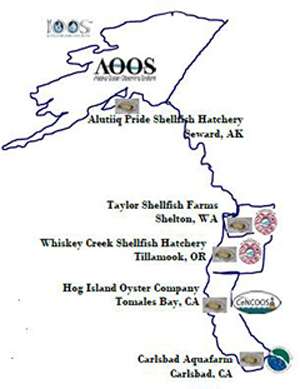Real-time ocean acidification data available to Pacific coast shellfish growers

Shellfish farms and hatcheries along the Pacific U.S. coast can now get real-time, online ocean acidification data through the Integrated Ocean Observation System (IOOS), a NOAA-led national-regional partnership working to provide new tools and forecasts to improve safety, enhance the economy, and protect the environment. The data, ranging from carbon dioxide concentrations to salinity and water temperatures can be found through the IOOS Pacific Region Ocean Acidification Data Portal which began operations this month.
"This new portal provides critical environmental intelligence to researchers, coastal managers, and end users such as shellfish aquaculture farms," said Libby Jewett, Ph.D., director of NOAA's Ocean Acidification Program. "We hope that the data gathered through this system, combined with on-going research, can help NOAA and our partners provide information to support effective adaptation strategies and other coastal resource decision making."
The IOOS Pacific Region Ocean Acidification Data Portal features data streams from five shellfish hatchery/growing sites using monitoring systems, dubbed "burkolators," that were developed by Burke Hales, Ph.D., Oregon State University. The monitoring systems, measuring ocean acidification variables, were recently installed at several Pacific coast sites including: Alutiiq Pride Shellfish Hatchery in Alaska, Taylor Shellfish Hatchery in Washington, Whiskey Creek Shellfish Hatchery in Oregon, Hog Island Oyster Co., in central California, and Carlsbad Aquafarm in southern California.
The portal also features data streams from NOAA's Pacific Marine Environmental Laboratory's ocean acidification moorings. Additional ocean acidification data streams from industry, academic, and government partners within Pacific coast regional IOOS associations will be added to the portal in the future.
Ocean acidification is primarily caused by carbon dioxide emissions into the atmosphere, which change seawater chemistry in a way that makes it difficult for many marine organisms to form their shells. Ocean acidification also poses a larger threat to marine ecosystems through food web effects which are still being explored. The resulting changes have both national and global environmental and economic implications.
In the United States, the shellfish aquaculture community is the largest segment of marine aquaculture, providing a nationwide harvest of over $600 million worth of sustainable shellfish, tens of thousands of jobs in rural coastal communities and helping to meet the country's demand for seafood. The growing impact of ocean acidification threatens the future of the industry.
Pacific coast shellfish hatcheries have seen the most notable impacts from ocean acidification that resulted in a near collapse of the shellfish industry and significant financial losses over the past decade.
Provided by NOAA Headquarters




















